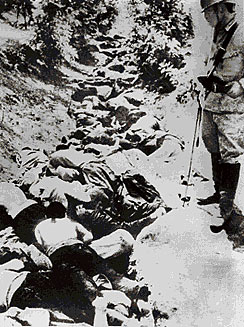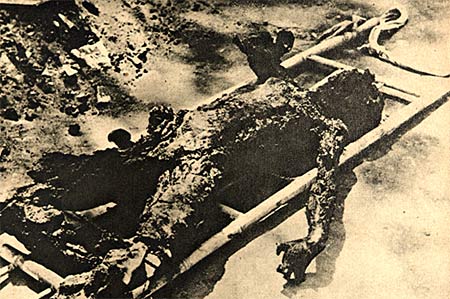Taday is a memorable day to our people, its 69th anniversary of Nanking Massacre. many of you might not as familiar with this history as how the German Nazi massacre the Jews in World War II, so I'll put some articles here to remind you what kind of terrible things was happened on the day of December 13, 1937.
_________________________________________
From Wikipedia:http://en.wikipedia.org/wiki/Nanking_Massacre
The Nanking Massacre, commonly known as "The Rape of Nanking", refers to the most well-known of the war crimes committed by the Japanese military carried out by Japanese troops in and around Nanjing (also known in English as Nanking), China, after it fell to the Imperial Japanese Army on December 13, 1937. The duration of the massacre is not clearly defined, although the period of carnage lasted well into the next six weeks, until early February 1938.
During the occupation of Nanjing, the Japanese army committed numerous atrocities, such as rape, looting, arson and the execution of prisoners of war and civilians. Although the executions began under the pretext of eliminating Chinese soldiers disguised as civilians, a large number of innocent men were wrongfully identified as enemy combatants and killed, or simply killed in any event as the massacre gathered momentum. A large number of women and children were also killed, as rape and murder became more widespread.
The extent of the atrocities is hotly debated, with numbers ranging from some Japanese claims of several hundred[citation needed], to the Chinese claim of a non-combatant death toll of 300,000. A number of Japanese researchers consider 100,000-200,000 be an approximate value[1]. Other nations usually believe the death toll to be between 150,000-300,000[citation needed]. This number was first promulgated in January of 1938 by Harold Timperly, a journalist in China during the Japanese invasion, based on reports from contemporary eyewitnesses. Many other sources, including Iris Chang's commercially-successful The Rape of Nanking, also promote 300,000 as the death toll.
In addition to the number of victims, a few extreme nationalists have even disputed whether or not the atrocity happened. Whilst the Japanese government has acknowledged such an incident did occur, the extremists presented their case starting with the Japanese army's claims at the International Military Tribunal for the Far East that the death toll was military in nature and that no such civilian atrocities ever occurred. However, an overwhelming amount of evidence contradicts this. The existence of such an atrocity has been repeatedly confirmed by statements of Westerners at the International Military Tribunal for the Far East as well as eyewitnesses then today, who had personally witnessed civilians being murdered and women raped by Japanese soldiers. There is also an extensive collection of photographic records of mutilated bodies of Chinese women and children. Recent archaeological findings further support the existence of this massacre having taken place.
The massacre is a major focal point of burgeoning Chinese nationalism, and in China, opinions are relatively homogenous[citation needed]. In Japan, however, public opinion over the severity of the massacre remains widely divided - this is evidenced by the fact that whereas some Japanese commentators refer to it as the 'Nanking massacre' (南京大虐殺, Nankin daigyakusatsu), others use the more ambivalent 'Nanking incident' (南京事件, Nankin jiken). The event continues to be a point of contention and controversy in Sino-Japanese relations.
______________________________________________
nearly 70 years past, some people in Japan still denied the Japanese government and militaries at that time should be condemned for the death of 300,000 innocent people, esp. most of politicians even their PM, while there are countless evidences, witnesses and survivors all pointing out that they were murderers
what do you think?
please discuss
_________________________________________
From Wikipedia:http://en.wikipedia.org/wiki/Nanking_Massacre
The Nanking Massacre, commonly known as "The Rape of Nanking", refers to the most well-known of the war crimes committed by the Japanese military carried out by Japanese troops in and around Nanjing (also known in English as Nanking), China, after it fell to the Imperial Japanese Army on December 13, 1937. The duration of the massacre is not clearly defined, although the period of carnage lasted well into the next six weeks, until early February 1938.
During the occupation of Nanjing, the Japanese army committed numerous atrocities, such as rape, looting, arson and the execution of prisoners of war and civilians. Although the executions began under the pretext of eliminating Chinese soldiers disguised as civilians, a large number of innocent men were wrongfully identified as enemy combatants and killed, or simply killed in any event as the massacre gathered momentum. A large number of women and children were also killed, as rape and murder became more widespread.
The extent of the atrocities is hotly debated, with numbers ranging from some Japanese claims of several hundred[citation needed], to the Chinese claim of a non-combatant death toll of 300,000. A number of Japanese researchers consider 100,000-200,000 be an approximate value[1]. Other nations usually believe the death toll to be between 150,000-300,000[citation needed]. This number was first promulgated in January of 1938 by Harold Timperly, a journalist in China during the Japanese invasion, based on reports from contemporary eyewitnesses. Many other sources, including Iris Chang's commercially-successful The Rape of Nanking, also promote 300,000 as the death toll.
In addition to the number of victims, a few extreme nationalists have even disputed whether or not the atrocity happened. Whilst the Japanese government has acknowledged such an incident did occur, the extremists presented their case starting with the Japanese army's claims at the International Military Tribunal for the Far East that the death toll was military in nature and that no such civilian atrocities ever occurred. However, an overwhelming amount of evidence contradicts this. The existence of such an atrocity has been repeatedly confirmed by statements of Westerners at the International Military Tribunal for the Far East as well as eyewitnesses then today, who had personally witnessed civilians being murdered and women raped by Japanese soldiers. There is also an extensive collection of photographic records of mutilated bodies of Chinese women and children. Recent archaeological findings further support the existence of this massacre having taken place.
The massacre is a major focal point of burgeoning Chinese nationalism, and in China, opinions are relatively homogenous[citation needed]. In Japan, however, public opinion over the severity of the massacre remains widely divided - this is evidenced by the fact that whereas some Japanese commentators refer to it as the 'Nanking massacre' (南京大虐殺, Nankin daigyakusatsu), others use the more ambivalent 'Nanking incident' (南京事件, Nankin jiken). The event continues to be a point of contention and controversy in Sino-Japanese relations.
______________________________________________
nearly 70 years past, some people in Japan still denied the Japanese government and militaries at that time should be condemned for the death of 300,000 innocent people, esp. most of politicians even their PM, while there are countless evidences, witnesses and survivors all pointing out that they were murderers
what do you think?
please discuss
 Buy on AliExpress.com
Buy on AliExpress.com






 My mistake. Sorry -- won't make that again!
My mistake. Sorry -- won't make that again!